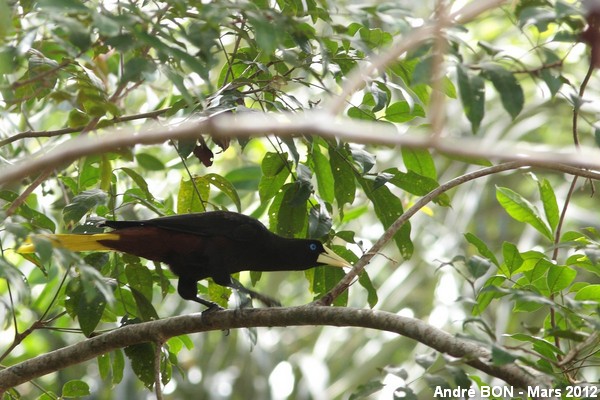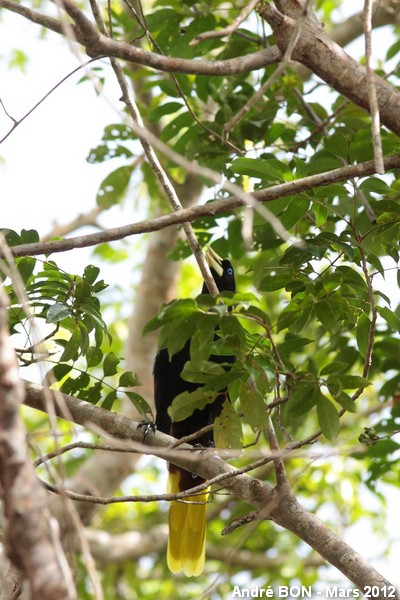

| Crested Oropendola (Psarocolius decumanus (Pallas, 1769)) |


|
|
Scientific name: Psarocolius decumanus (Pallas, 1769) Common name: Crested Oropendola Other names: Suriname Crested Oropendola French name: Cassique huppé Order: Passeriformes Family: Icteridae Size: Body size: 36–38 cm for females, 46–48 cm for males; Weight: about 180 g for females and 300 g for males. Habitat: Woodland edges, clearings, Bamboo clumps, cultivated areas. Various habitats but Crested Oropendola needs high isolated trees for nesting. It also avoids very dry places. Food: Insects, seeds, fruits and nectar on flowers. Nesting: Crested Oropendola nest in colonies of 2 to 30 nests located high on large isolated trees. Isolation provides protection from potential predators such as monkeys or snakes. Nests built by females, have the form of long hanging baskets (up to 1.25 m in length). The opening is upwards. Each clutch has one or two eggs. Migration: Sedentary but Crested Oropendola are rather mobile and can move locally. Geographic area: South America east of the Andes, from Panama and Colombia in the north, south to north-east Argentina. Trinidad and Tobago. Its range may be extending as it was observed in Costa Rica in 1999. It is generally found below the altitude of 1000 m (though it has been observed at 2600 m in Colombia). |
The adult male shows an almost totally black plumage. The rump and the matching parts on the underside of the body are brown. The tail is yellow except two central black feathers on the upper side, slightly shorter than the other ones. The head is black with a thin black crest which is only visible when the bird is excited. The bill is conical and ivory coloured. The eyes are blue turquoise. The legs are black. Females are similar to males but smaller and duller. Their crest is reduced. |
| [To know more about the Crested Oropendola] [Next picture] [Top] |

|
I have shot this picture at Awala Yalimapo in the garden of the WWF centre dedicated to the protection of sea turtles. The night walk, in the moon light, to observe Green Sea Turtles laying their eggs (I should have come later in the season to observe Leatherback Sea Turtles) remains one of my best souvenir of my short stay in French Guiana. |
| [To know more about the Crested Oropendola] [Previous picture] [Top] |

|
This Crested Oropendola flew from one tree to the other but I have not been fast enough to shoot a nice picture in flight. So we will just enjoy a picture of the bird landed on the tree and partially hidden by the foliage. The two black feathers on the upper side of the tail are visible by transparency. |